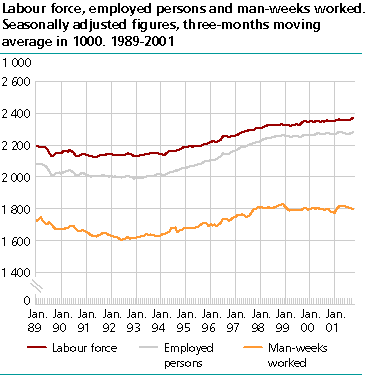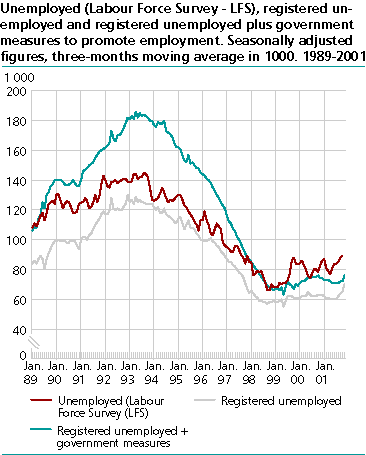Content
Published:
This is an archived release.
Employment and unemployment slightly up
Unemployment and employment have during the last two years shown a weak increase. As for earlier 3-months periods, the latest figures from the Labour Force Survey (LFS) show increases that are within the error margins.
Neither the number of employed persons, unemployed persons nor man-weeks worked show any big changes from the 3-months period of June, July and August 2001 to September - November, according to seasonally adjusted figures from the Labour Force Survey (LFS).
Adjusted for seasonal variations, the number of unemployed persons rose by 6 000 from the 3-months period (June - August) 2001 to (September - November). The number of unemployed persons in the 3-months period (August - October) this year constitutes 3.8 per cent of the labour force, compared with 3.6 per cent in the previous 3-months period. The 0.2 percentage points increase are within the error margins in the LFS caused by the sample uncertainty.
Seasonally adjusted figures of registered unemployed the last couple of months can indicate an increase in the unemployment.
The purpose of adjusting for seasonal variations is to describe the development during the last year and to give figures for change between the last two 3-months periods cleared for normal seasonal variations. In order to reduce uncertainty, the presented series are three months moving averages of the seasonally adjusted figures. For instance the figure from October is the average of the estimates from September, October and November.
Tables:
The statistics is published with Labour force survey.
Contact
-
Arbeidsmarked og lønn
E-mail: arbeidsmarked@ssb.no
-
Erik Herstad Horgen
E-mail: erik.horgen@ssb.no
tel.: (+47) 93 08 68 62


